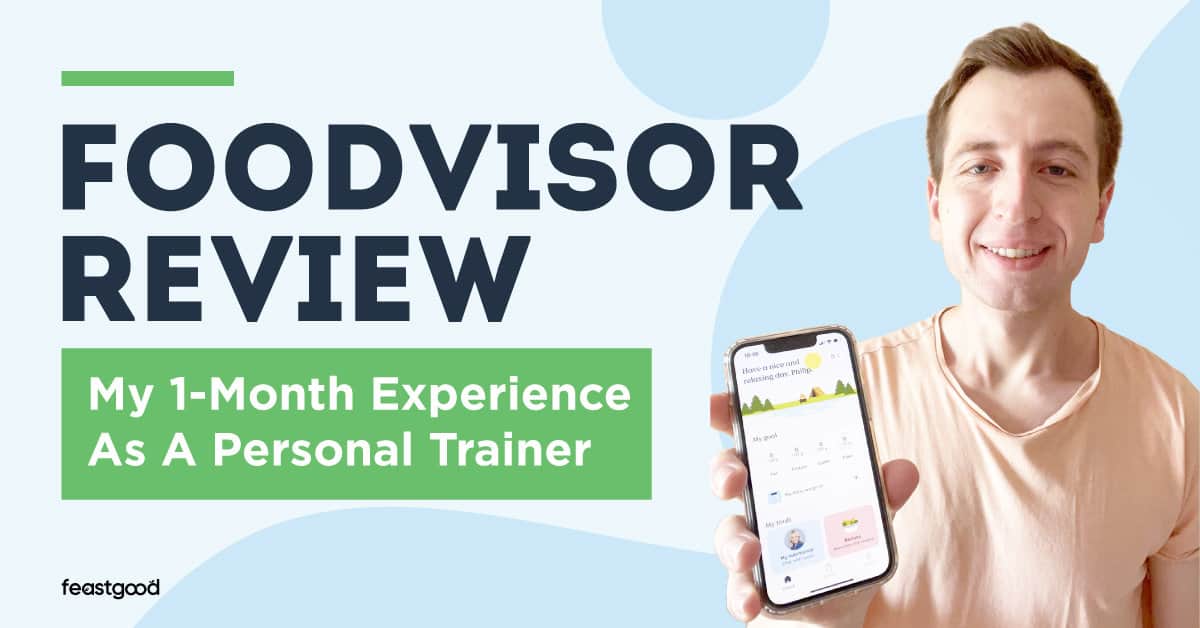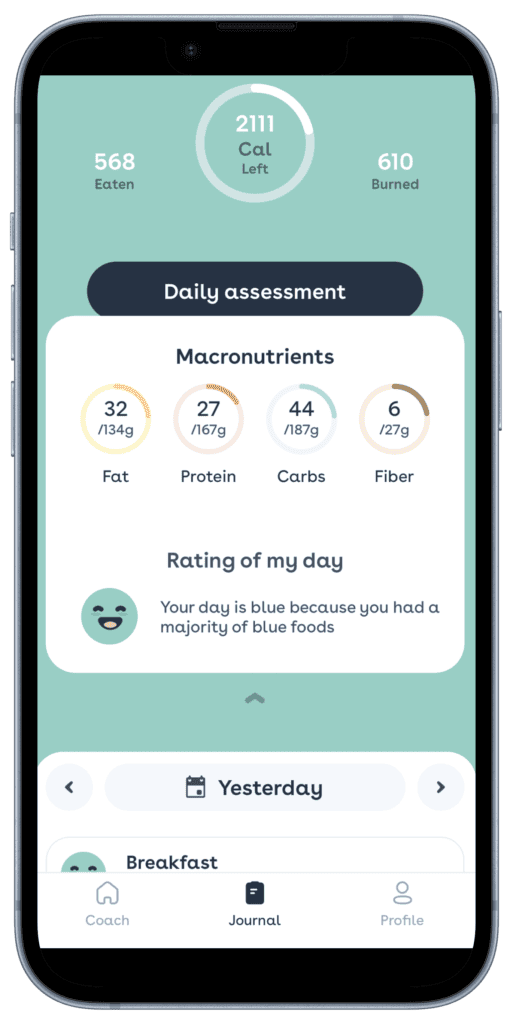Let’s say that you’re looking for a simple diet app to start eating better, log your meals with ease, and gain access to a nutrition expert who can answer your questions. Foodvisor promises to do all these things (and more), so let’s see if that is true based on my recent 1-month experience.
Key Takeaways
- Foodvisor is a blend of food tracking, accountability, education, and one-on-one support. From my experience testing over 22 nutrition apps, you can find nutrition apps that do one or two of these things well, but combining all into a single app is unique.
- Foodvisor provides tailored calorie and macronutrient targets based on personal preferences, goals, and struggles. This level of personalization was evident as soon as I completed the onboarding questionnaire, which were based on my activity level and body composition goals.
- Foodvisor has a recipe database better than other apps I’ve tested, such as FatSecret and 8Fit, giving users plenty of options for healthy meals to stay on track with their diet and nutritional targets.
- Foodvisor has a comprehensive and accurate food database that gives users the confidence to know that the food they log contains precise information on calories, macronutrients, and vitamins/minerals (surprisingly, not every app has an accurate food database).
Medical Disclaimer: The content of this article is provided for educational insights only. It should not be used as medical guidance. Individuals with a past of disordered eating should refrain from weight loss programs or calorie tracking. For medical advice, consult a certified healthcare professional. If you’re struggling with eating disorders, contact NEDA for assistance.

My Opinion on Foodvisor As A Personal Trainer
I track my food intake regularly and always look for more straightforward ways to log my meals. Also, as a personal trainer, I always get asked about my approach to food logging and what I think about various diets and fitness apps.
So, what’s my take on Foodvisor?
Well, the app doesn’t have the established brand name of MyFitnessPal, the backing of experts and influencers like MacroFactor or Carbon Diet Coach, or the funding of a giant like Noom.
However, I still think Foodvisor is a force to be reckoned with and has a place in the nutritional app market.
Given its simplicity and the unique way it gets users to take action as soon as they log in, Foodvisor could be the solution some people need to take control of their diet, learn the basics, and get the ball rolling.
The app lacks some features like:
- The ability to share food logs with other people (coach, health professional, etc.)
- Being able to record body measurements and body fat
- Upload progress photos
- Nutritional targets that update automatically based on weight trends and other factors
However, it makes up for some of its shortcomings by giving people access to a nutritionist (a huge value), keeping people accountable through daily reminders, and making it easy to record food and water intake, and daily weigh-in.
More than anything, I believe Foodvisor can be a useful tool because it’s not intrusive and doesn’t ask people to do a lot every day. Log a meal here, record your weight there, ask your nutritionist a question or two, read a helpful article, and go about your day.
It can add up to tremendous changes in the long run when repeated daily.
Overall, I recommend the app to people just getting started with healthier eating/food logging or those who could use support from an expert when they aren’t sure what to do.
How Does Foodvisor Work?
Foodvisor is a nutrition app designed to help people eat better, improve their relationship with food, track calories and macronutrients, drink more water, and build better habits.
The app provides guidance based on numerous personalized factors, including:
- Age
- Gender
- Height
- Weight
- Fitness and health goals (fit in old clothes, look more muscular, lose weight, etc.)
- Dietary preferences
- Environmental factors (do you have time, are you a parent, where do you live, etc.)
- How quickly you want to reach your goals
Depending on the answers you provide during the setup process, Foodvisor creates a personalized dashboard with features that make sense to you.
For example, someone who wants to track calories and macronutrients will see their nutritional targets displayed front and center.
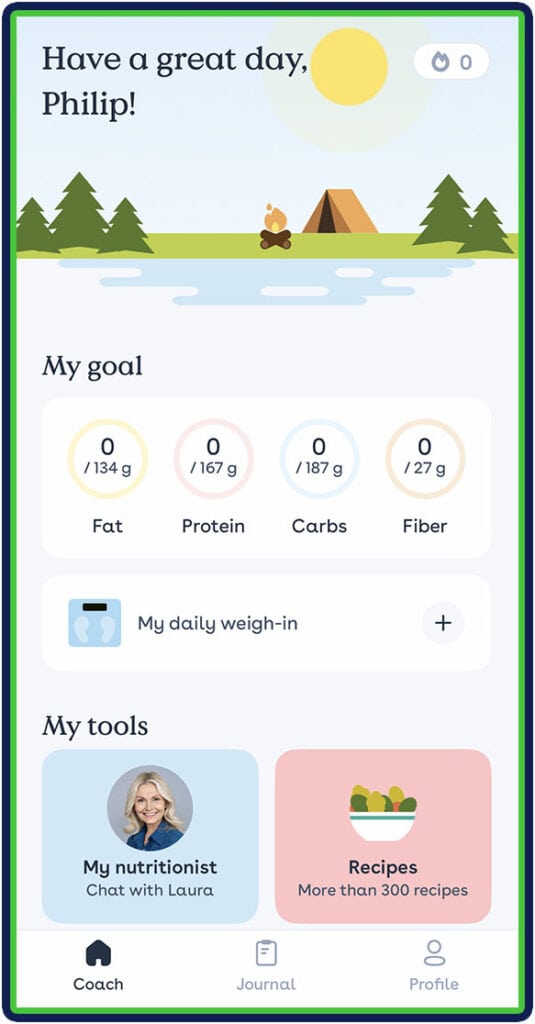
The app encourages consistency by sending reminders to log your weight and meals, but you can turn those off if you want.
In addition, users gain access to a nutritionist (a real person, not a chatbot). The responses pleasantly surprised me, but I’ll share more about my interactions with my assigned nutritionist later.
Foodvisor also has a rich library of helpful resources (articles) you can access inside the app. These cover various nutritional topics and are jam-packed with actionable and specific information.
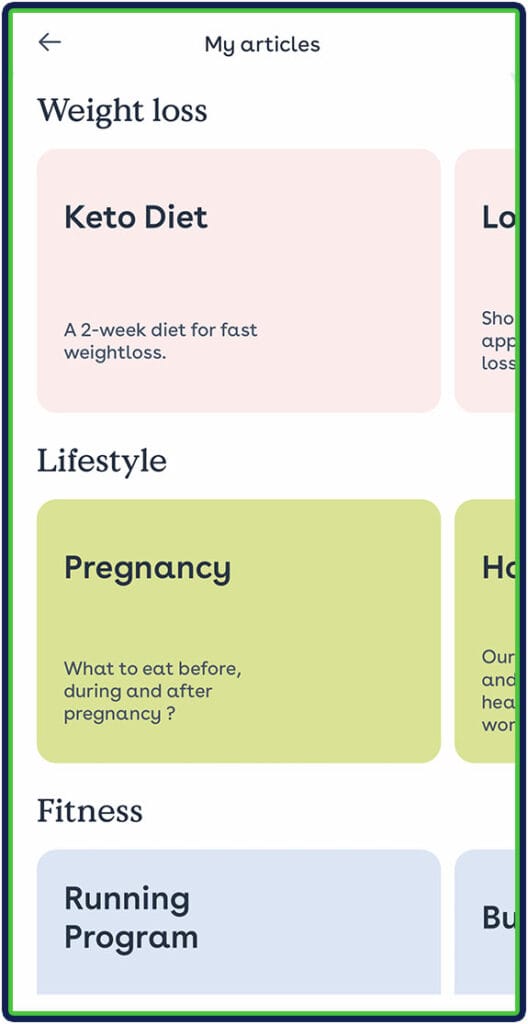
Key Features
- Log Meals Through Photos/Camera: While not perfect, the app can recognize what’s on your plate by taking a picture, allowing a fast food logging process.
- Personalized Nutritional Targets: Once you go through the initial questionnaire and select your preferred speed to reach your goals, the app provides tailored nutrition recommendations.
- Track Physical Activity: The app has an extensive list of activities users can pick from and log. It also has a ‘Sports mode,’ which automatically adds the calories burned to your daily total. (You can keep it turned off if you wish.)
- Access to a Nutritionist: You get 1:1 chat access to your assigned nutritionist, where you can ask questions about your diet, food choices, nutritional targets, and anything else you’re unsure about.
- Good Food and Recipe Databases: Foodvisor’s food and recipe databases are quite extensive, and each entry includes a detailed nutritional breakdown and all the other relevant information you need to make better choices.
- Educational Resources Inside the App: The app uses the data it gathered during the sign-up process to organize educational resources for users. I could also pick from their large library of 500+ existing articles that were broken down and easy to digest.
What I Liked About Foodvisor
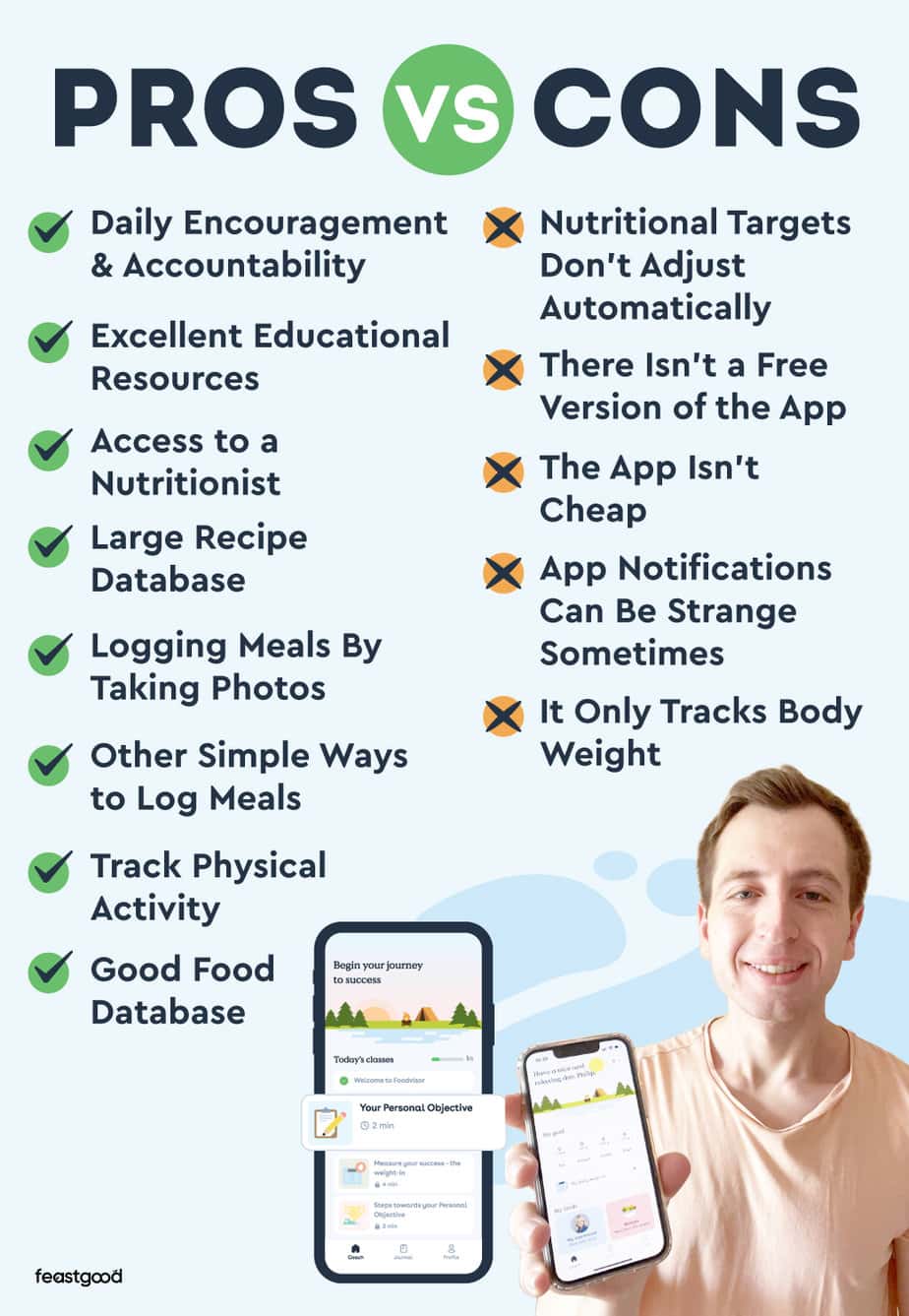
1. Daily Encouragement and Accountability
Foodvisor encourages consistency with meal logging, weight tracking, and water intake.
When I log in, the app displays my nutritional goals. Below that, I have an option to add my daily weigh-in.
When I tap on the goal section, I can log my next meal (or previous ones, in case I haven’t logged them), add an activity, and record my water intake in 0.25l increments.
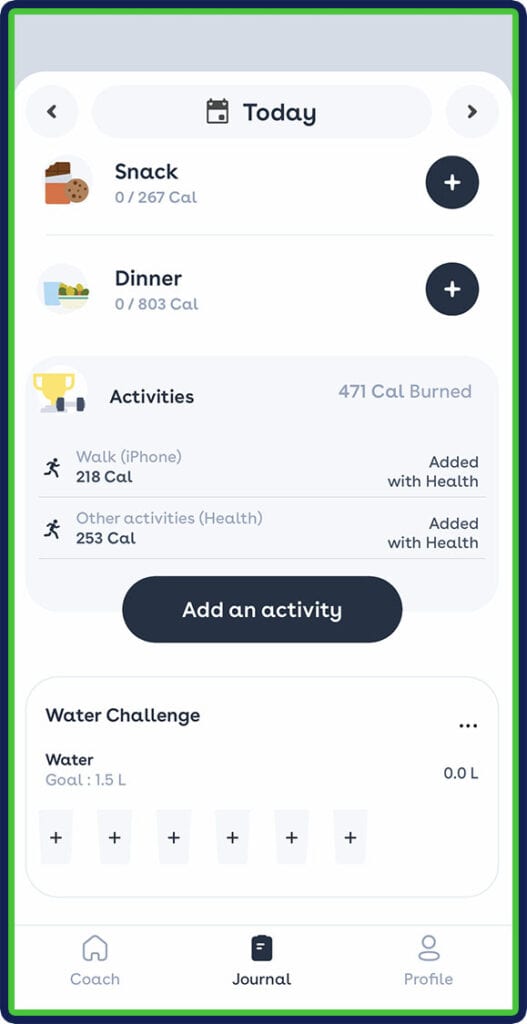
The app diligently reminds me to log my meals and notifies me about my daily nutrition classes when they are ready.
In other words, when I log in, the app gets me to do something immediately.
I like this aspect of the app because there is a sense of accountability. Foodvisor’s interface is designed to make users feel good when they check off boxes.
As a personal trainer, I know how difficult it can be to foster consistency in clients, and Foodvisor does an excellent job of getting people to act and get closer to their goals.
2. Excellent Educational Resources
During the setup process, Foodvisor collected as much information as possible about me to understand my goals, the roadblocks I’ve faced, and what short-term objectives I want to achieve. The app then used that information to generate new daily classes.
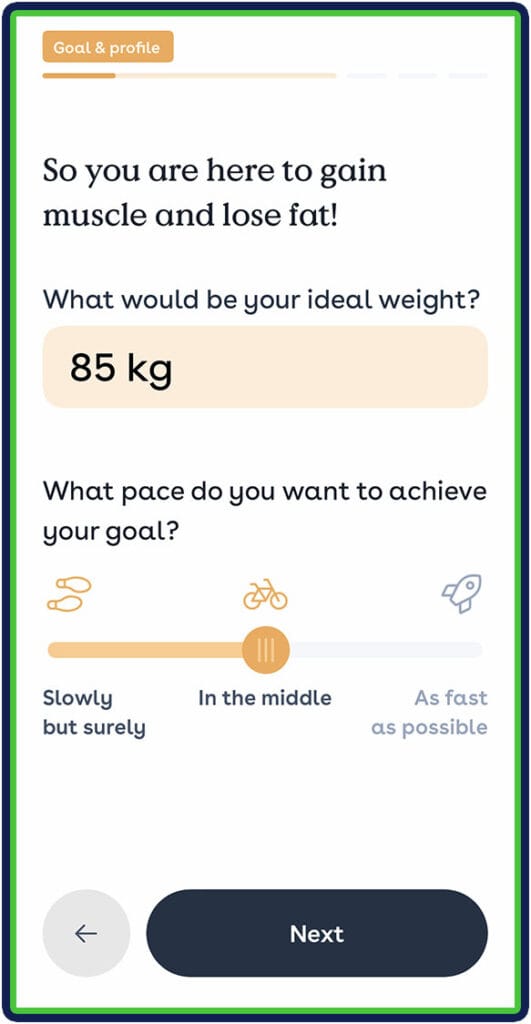
For example, I wanted to see Foodvisor’s weight loss and nutrition resources, so I picked those during the set-up stage. The app now presents me with help on nutrition, sustainable exercise, hydration, behavioral change, stress management, and sleep.
It’s worth noting that class selection is personalized based on the answers given in the initial questionnaire. For instance, someone primarily interested in weight loss will learn more about calorie deficits, rate of fat loss, protein and its importance, hunger management, etc.
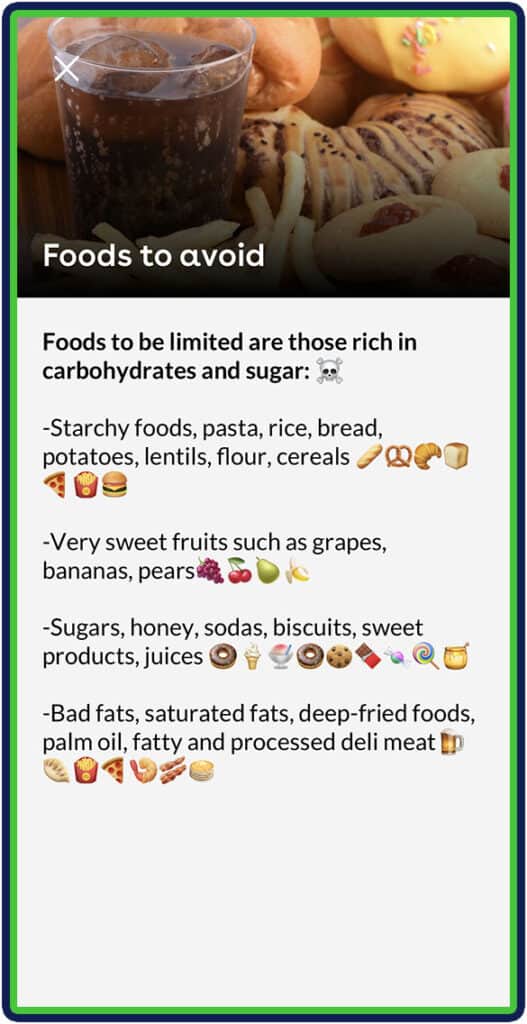
In contrast, someone who wants to learn about cognitive behavioral therapy (CBT) and building better habits will get more resources on such topics.
What I found to be excellent is that, regardless of my questionnaire answers, the app gave me full access to the 500+ articles available. Should I want to learn about something else, I can.
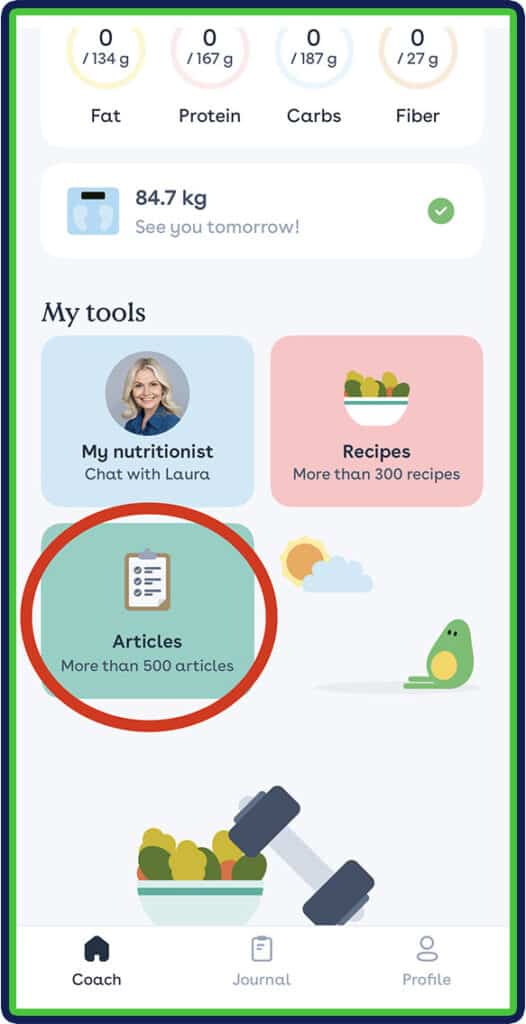
3. Access to a Nutritionist
In today’s age of AI chatbots, having access to an actual human expert is refreshing and, let’s face it, surprising. Foodvisor’s dashboard has a ‘My Nutritionist’ section. When I click on it, a chat opens, and I can ask my assigned nutritionist questions.
The feature pleasantly surprised me because access to an expert is typically tied to monthly coaching fees, which was the case when using Betterme (click to read my review). However, with Foodvisor, that feature came as a bonus, even during my free trial.
I chatted with my nutritionist (Laura) and asked questions requiring an expert’s thoughts and input. She followed up with some questions to better understand my situation and then provided simple, helpful, and accurate advice.
For example, I asked her if she thought my protein target was too low. I told her I typically eat 200 grams of protein and that perhaps eating more would help me feel fuller during caloric restriction.
She asked me about my typical day if I spend a lot of time seated, how much physical activity I get on average, and what my goals with Foodvisor were.
After telling her about my typical day, exercise habits, and goals, she confirmed that the protein target was accurate (I agreed with her estimation) but told me I could bump it to around 30% of my calories.
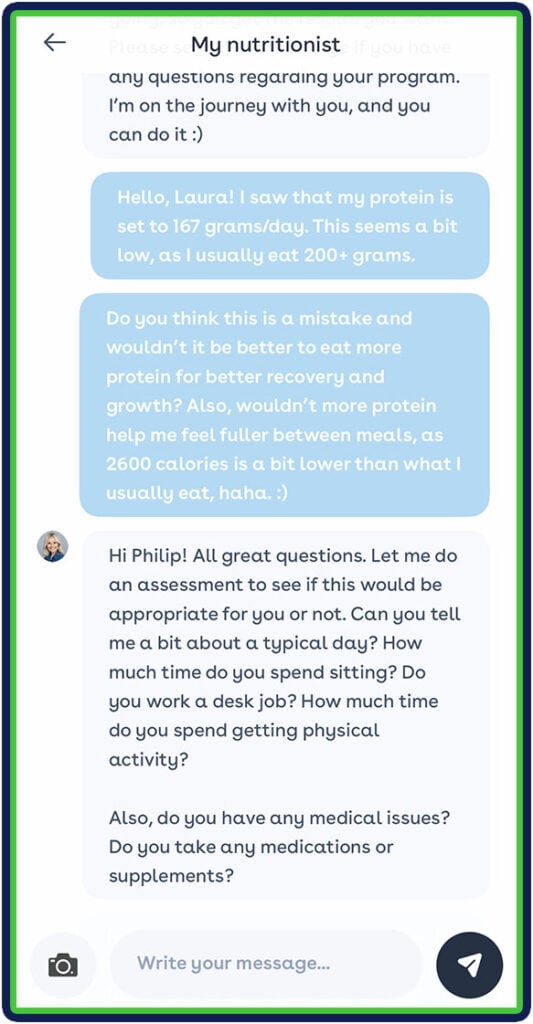
Later, I asked about her thoughts on plant protein and if I should eat more grams to account for the low amounts of certain amino acids in some sources.
She provided me with a list of good plant-based proteins and recommended eating various plant foods to ensure I get enough of all essential amino acids. Another piece of excellent advice.
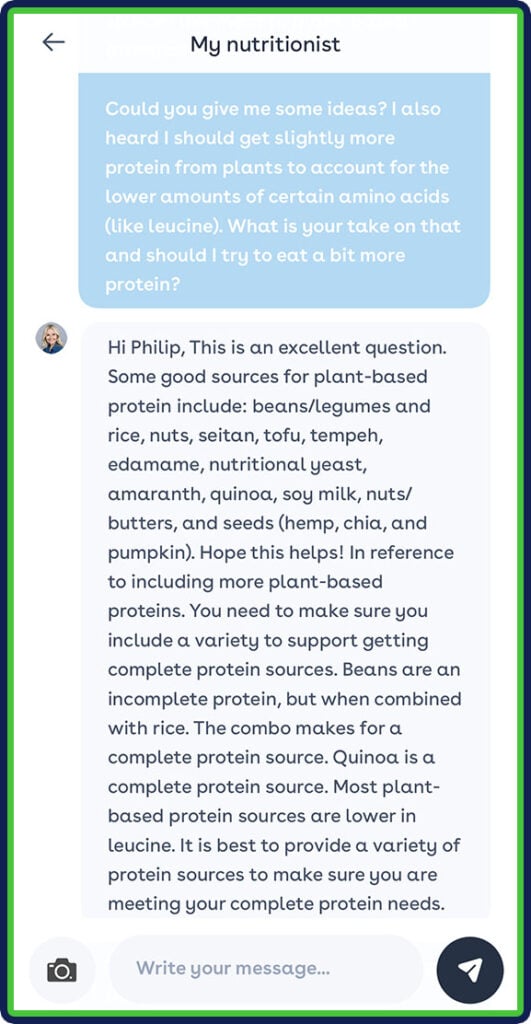
Overall, I think the feature is excellent. Laura went above and beyond to answer my questions, give specific tips, and follow up with her inquiries to understand my situation better.
The only drawback is that nutritionists on the app don’t reply immediately. Mine replied between 9:00 AM and 7:00 PM, usually within a few hours.
Being realistic, though, even if you hired a nutrition coach or personal trainer, they’re likely not sitting around checking their emails and texts 24/7, so a two-hour turnaround time within daylight hours is reasonable.
4. Large Recipe Database
Another feature found on the dashboard of Foodvisor is the ‘Recipes’ section, which features 300+ healthy and delicious recipes.
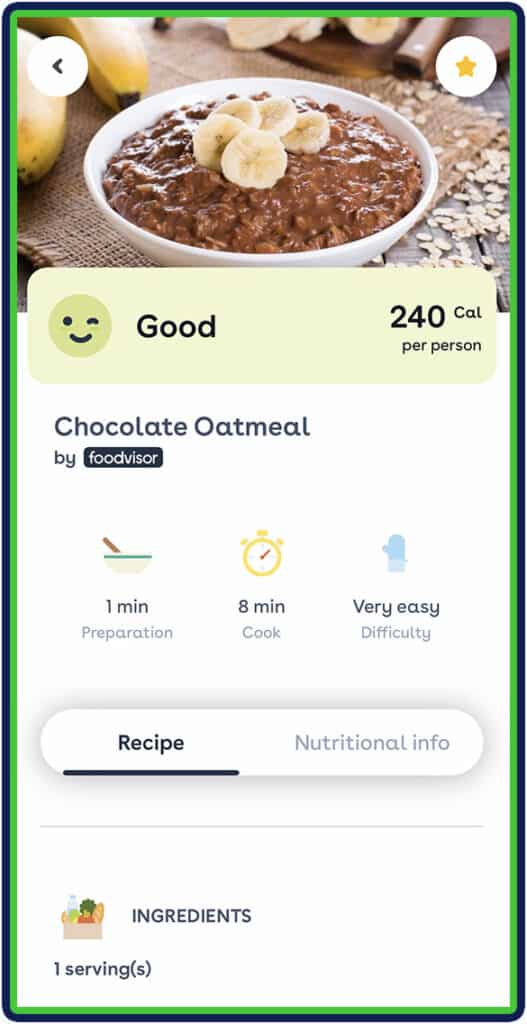
Each recipe comes with a photo and information on how long it takes to prepare and how difficult it is.
There is also a list of the ingredients, step-by-step directions, and an in-depth nutritional breakdown similar to what you’d see for entries in MacroFactor’s food database (another nutrition app I’ve reviewed and rated very highly).
What’s cool about the entries is that the app automatically calculates what percentage of my daily calories a recipe would take and how the nutrients contribute to my daily total.
For example, the Chocolate Oatmeal recipe represents 8% of my daily intake and added 7 grams to my 167 grams protein target for the day.
The app’s visualization makes it easy for me to understand the impact of each food or recipe.
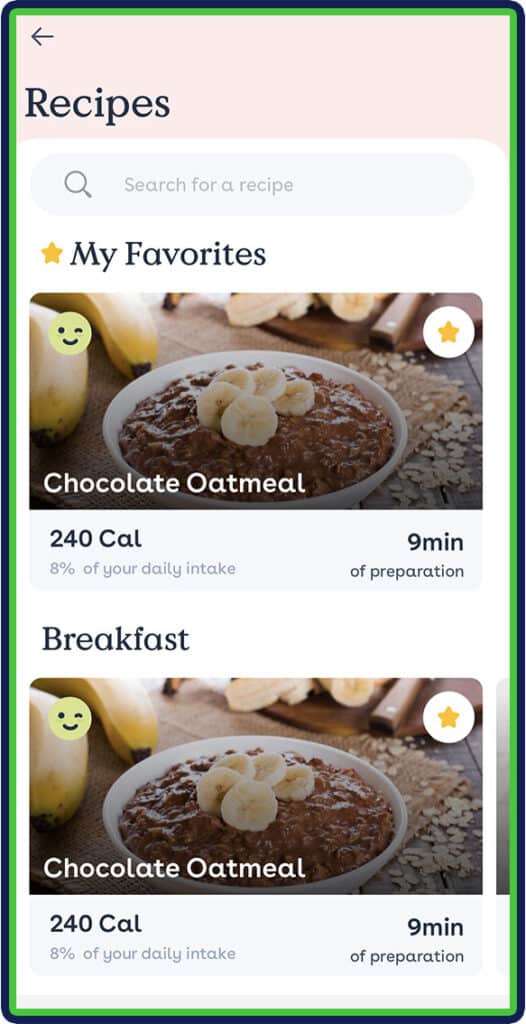
I can add recipes to my diary instead of manually inputting each meal. However, I must prepare each recipe exactly as the app presents. In other words, I couldn’t modify the recipe, which I didn’t feel I had to do anyway, but it was worth noting).
Overall, I found the recipe database to be fantastic. Even if I don’t copy recipes and must input them manually, they still serve as inspiration for when I’m not sure what I want to eat, but I want it to be healthy and fit my calories and macronutrients.
5. Logging Meals By Taking Photos
One of the more frustrating things about many nutrition-tracking apps is the difficulty of logging meals. So, I was interested to see how Foodvisor handles that.
The first thing I was eager to test was logging meals with photos. Other apps have tried and failed here (FatSecret being one of them), so I was interested to see how Foodvisor managed, given that they advertise that feature on their main page.
I tested the feature for multiple meals and even pointed my phone camera at photos of various meals I found online. From what I saw, the feature is good (not perfect), and generally guesses what’s on my plate.
For example, steak cut into small pieces with potatoes and other chopped vegetables tracked properly. However, it struggled with more complex meals, especially those in a bowl – like oatmeal – where not all the ingredients are visible.
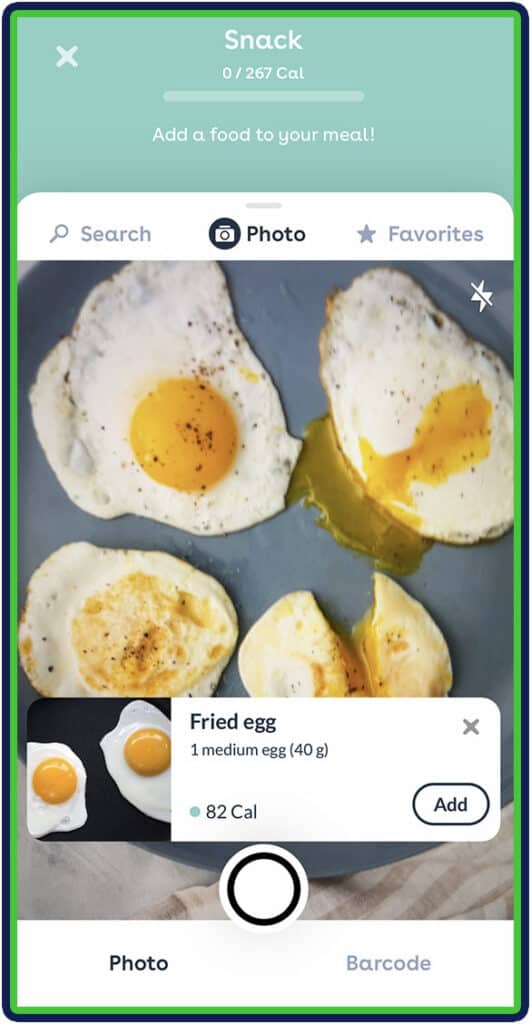
Fortunately, the folks at Foodvisor are aware that the feature isn’t perfect.
Once the app ‘guesses’ what’s on my plate, a new window opens where I can individually select the foods (and respective servings), replace certain foods with alternatives, and leave feedback.
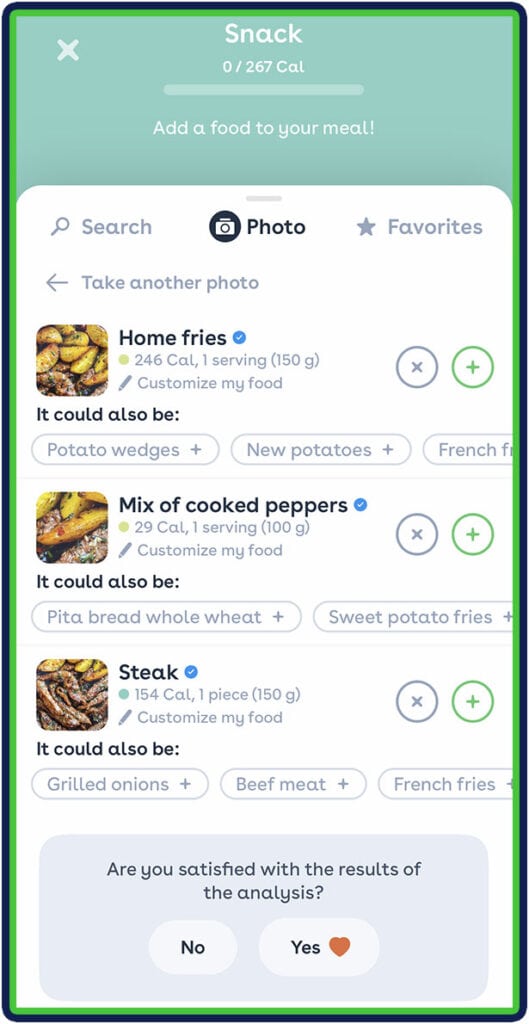
I honestly didn’t expect logging photos with this feature to be perfect, but it’s better than expected, and I’m excited to see how it evolves in the next couple of years.
- Related Article: SnapCalorie Review: Is It The FUTURE of Calorie Tracking?
6. Other Simple Ways to Log Meals
I can also easily log foods I’ve eaten previously without using the search bar, which works great because I often eat the same things daily.
It also becomes increasingly useful as I log more meals because the list expands, allowing me to tap on the foods I want to log quickly.
The search bar is also great as the app’s vast food database and entries come with nutritional breakdowns.
I particularly like this about Foodvisor because it takes the guesswork out of the equation and allows me to accurately log my meals without double-checking the nutritional information of the foods I’m eating elsewhere.
Some foods and beverages even have information about their benefits, further giving me insight into the impact of my dietary choices. For instance, sweet potato was listed to help with high blood pressure.
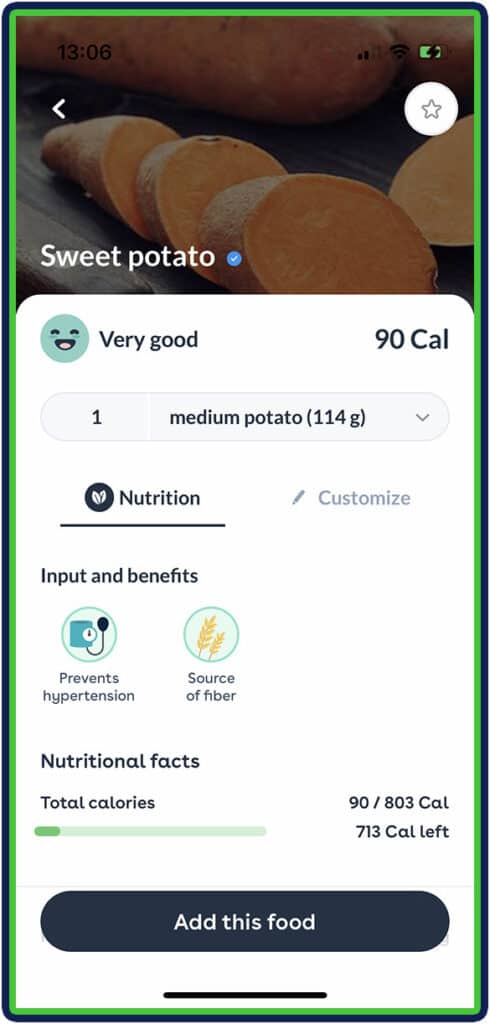
Like most nutrition apps, Foodvisor also has a barcode scanner, making it easy to log packaged foods. I tested this several times, and it was always accurate.
It never feels like a chore to log my meals. It rarely takes me longer than a couple of minutes between the multiple options.
7. Track Physical Activity
Foodvisor allows me to log any physical activity I do. It provides an extensive alphabetized list and automatically estimates the caloric burn once I input the effort level (light, moderate, vigorous, etc).
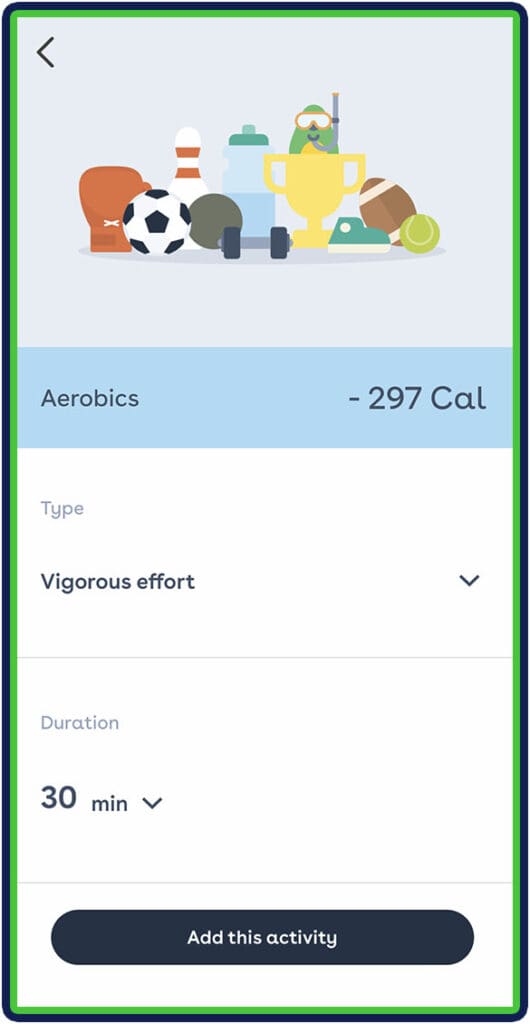
For specific options like boxing, the app allows me to pick the type––for example, working a punching bag, sparring with a partner, or competing.
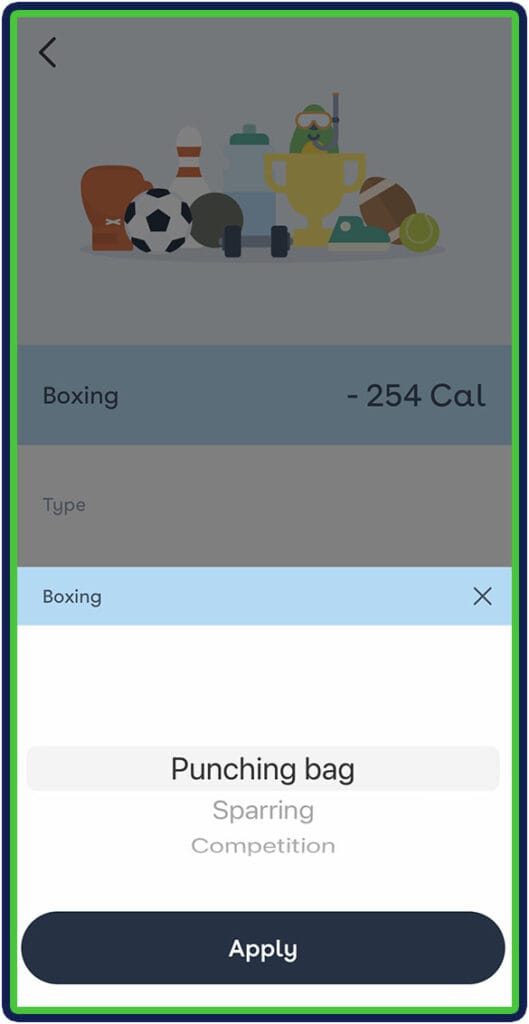
In the case of cycling, I can estimate my effort based on speed.
The app made it effortless for me to add the exact type of activity I’ve done with all the necessary details.
There is also a Sports mode, where the calories I burn during physical activity are added to my daily caloric total.
The cool thing is that I could keep this feature turned off, which is helpful if you’re trying to lose weight and you don’t want the calories you burn added back into the calories you need to eat.
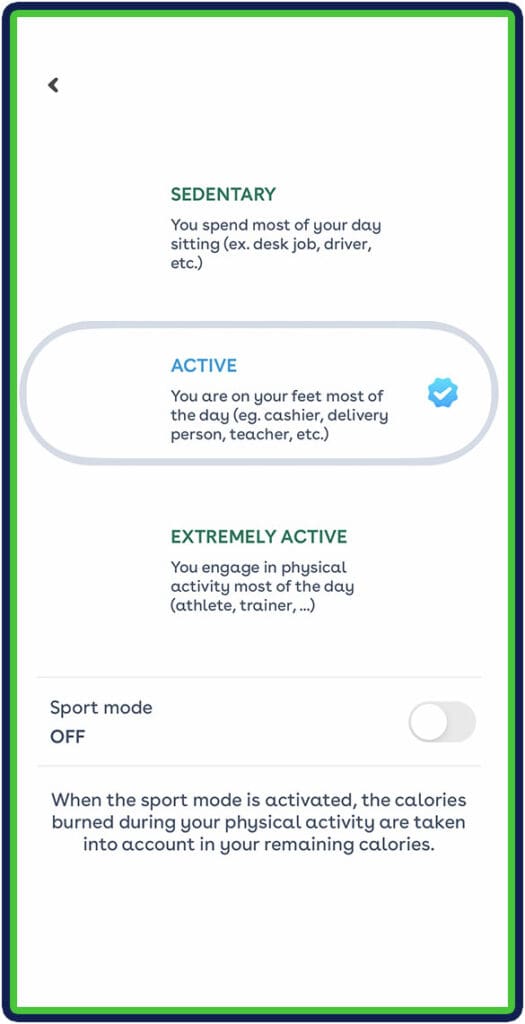
8. Good Food Database
Foodvisor’s food database is extensive. I never struggled to find the foods I ate in their database.
Each entry also includes a detailed nutritional breakdown of calories, macronutrients, and vitamins and minerals.
While this feature is expected in any food tracking app, what I found great about Foodvisor is that the information is accurate, unlike other apps I’ve tested (like MyFitnessPal).
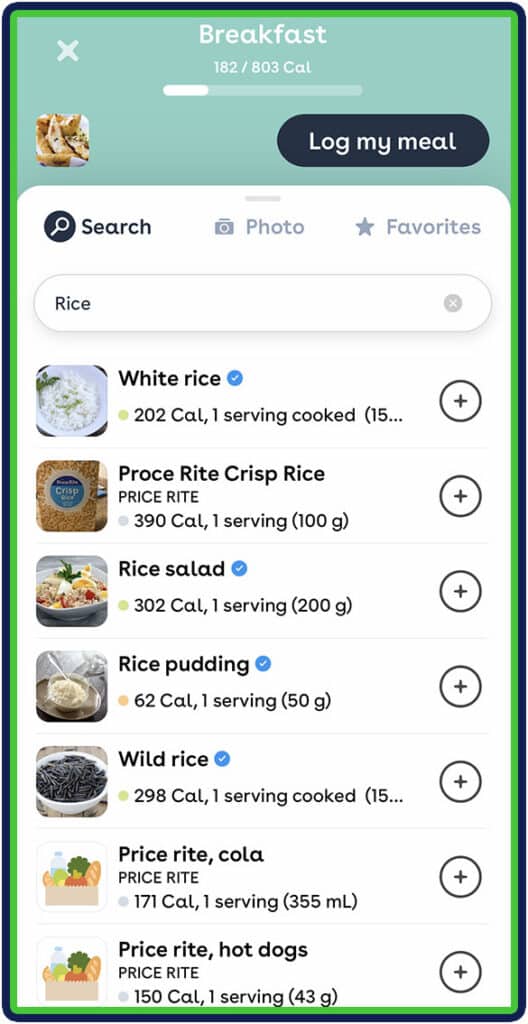
What I Didn’t Like About Foodvisor
1. Nutritional Targets Don’t Adjust Automatically
Some apps like MacroFactor and Carbon Diet Coach automatically adjust my nutritional targets based on my weight trend and other factors. Sadly, I didn’t see that happen when using Foodvisor.
Once I got my initial targets, that was pretty much it, no matter what happens to my body weight over time. If I want to lose weight, my initial targets will eventually stop producing results, and my weight will plateau.
In contrast to how Foodvisor handles this, an app like MacroFactor would automatically adjust my calorie and macro targets if it detects a plateau or senses that progress is slowing down. That way, once I complete my weekly check-in, I will have new daily nutritional goals.
That said, I must give Foodvisor some credit because my assigned nutritionist does an excellent job answering my questions. When the topic of calorie intake came up, Laura advised me to keep my calories the same, which means she provides calorie intake recommendations.
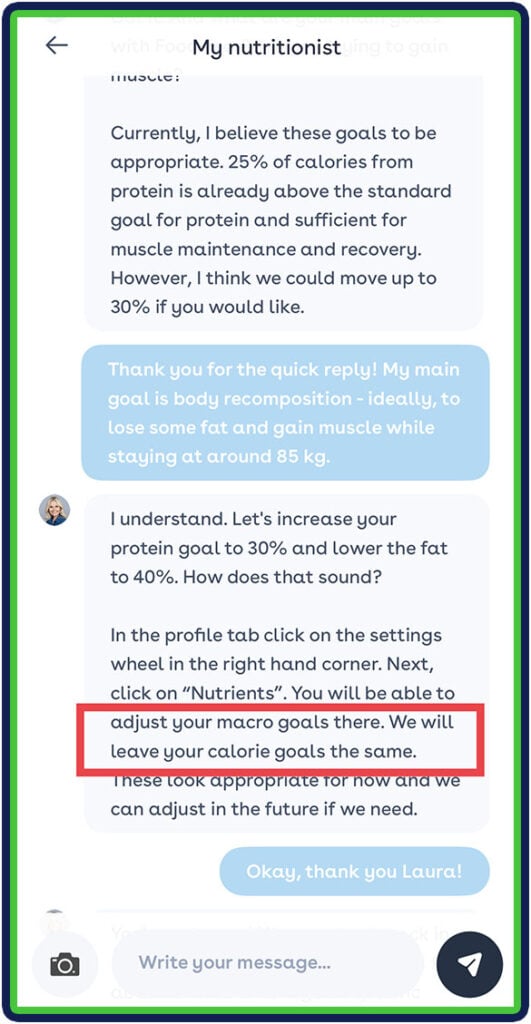
1. There Isn’t a Free Version of the App
Unfortunately, Foodvisor doesn’t offer a free version. The only option was a 14-day free trial, which was plenty of time to test the app and decide if it fit me well. It came with all the features, including access to a nutritionist.
I noticed that the app doesn’t overtly offer a 14-day trial but only gave me the option of one once I completed the lengthy sign-in process and declined to subscribe. This is certainly not a new tactic, as I’ve seen other companies do that, but it always irks me.
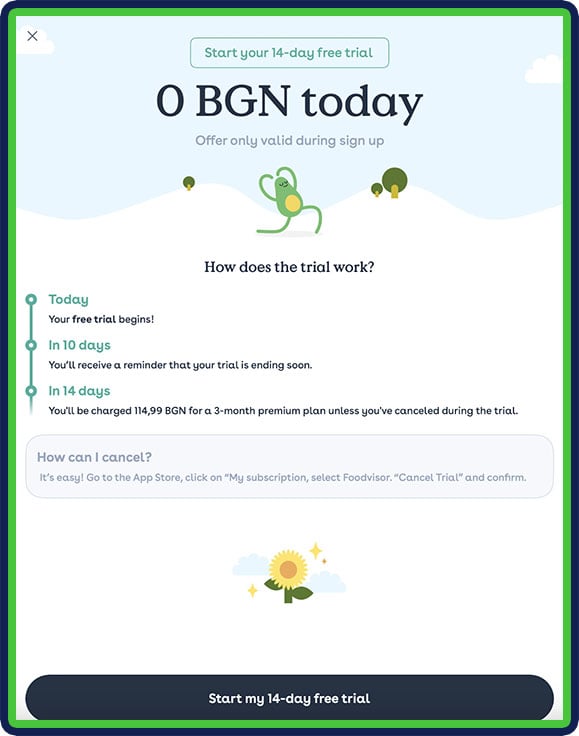
2. The App Isn’t Cheap
The app isn’t cheap. It costs $29.99 on a monthly plan, which is more than most other nutrition-tracking apps.
So, if you only plan to use Foodvisor as a meal-logging app, the cost wouldn’t be justified because you could get the same features at a lower price with another app.
However, the cost is justified for people who take full advantage of the app, including talking to their assigned nutritionist.
For example, two other apps with a “talk to a coach” feature are BetterMe and Noom, and both are more expensive than Foodvisor.
- BetterMe asks you to pay an additional $4 just to talk to a coach, and then you have to pay an additional $99 for a personalized program.
- Noom’s cheapest option is $169 for four months (billed upfront), totaling $42.25/month.
So, if you look at it from this angle, Foodvisor is one of the cheapest options for people looking to leverage the in-app coaching experience.
3. App Notifications Can Be Strange Sometimes
There’s a ‘manage my notifications’ section under the app’s settings, where I choose which notifications to get and when. However, they don’t seem to work perfectly.
For example, I’ve set my meal reminders at 7:45 AM (breakfast), 12:30 PM (lunch), and 7:00 PM (dinner). However, the app seems to send these more than once for each meal, which can be annoying.
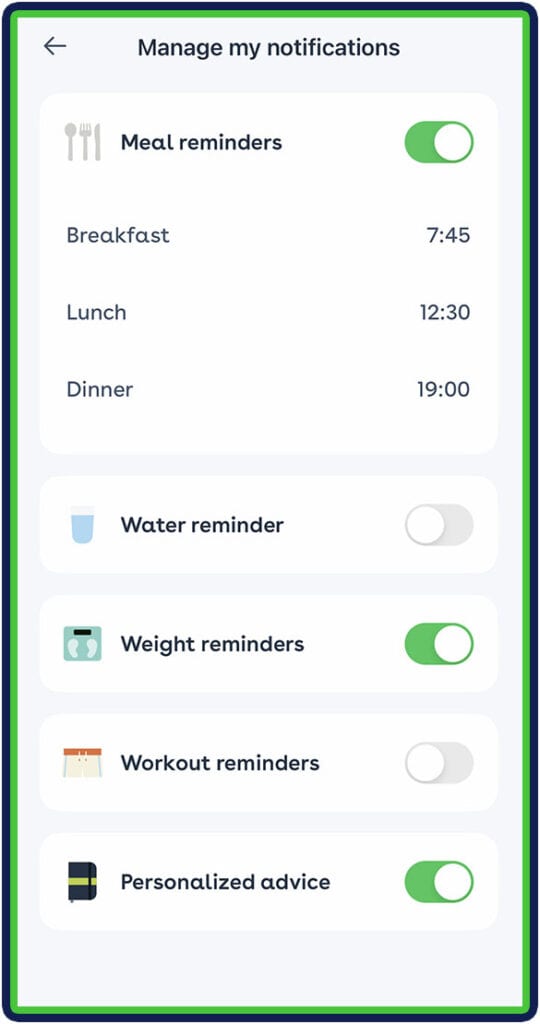
It does so even if I immediately click the first notification and log my meal. Sure enough, I’d get a second notification for a meal I’d logged 5, 10, or 20 minutes ago.
Additionally, the app doesn’t seem to display all notifications.
For example, I’ve selected weight reminders and personalized advice but haven’t seen any. This is certainly not a deal-breaker for me, but it’s something Foodvisor hopefully fixes in its upcoming releases.
4. It Only Tracks Body Weight
The app does a great job of tracking body weight and shows a beautiful graph. That said, Foodvisor doesn’t allow me to track other metrics: body fat percentage, body measurements (arms, legs, waist, etc.), or upload progress photos like MacroFactor.
As a coach, I understand the value of tracking body weight, but it’s not the only measure of success, especially when it comes to a weight loss phase.
Many people will see changes to their body composition but not on the scale because they’re losing fat and gaining muscle simultaneously.
Foodvisor also doesn’t allow you to track health metrics like blood pressure or glucose like Cronometer and Noom. I don’t mind that, but this could be a deal-breaker for people who want to monitor these (and similar metrics) to manage a health condition.
What Other Customers Think
The app has 4.3 stars on Google Play with 8,400+ reviews. There is a trend among positive reviews that the app is great for accountability with its daily reminders. Users also liked that they could track their nutrition, water intake, body weight, and physical activity.
Some users also praised the daily educational content as simple, easy to digest, and helpful.
However, many recent users criticized the app for being buggy (the Android version), freezing suddenly, and displaying an error ‘No internet connection’ despite that not being the case.
Some users also seem frustrated with logging meals by taking photos, claiming the feature doesn’t work nearly as well as advertised.
A few reviewers also claimed that their chat with the nutritionist wasn’t all that helpful and that it sometimes felt like chatting with an AI instead of a real person. This wasn’t the case for me.
On the App Store, Foodvisor currently has a 4.5-star rating with 7,700+ reviews. People who liked the app generally praised it for the structure it provided and how it made their nutrition simpler. Many also mentioned their chats with the assigned nutritionist as helpful and eye-opening.
The interface’s simplicity also appeared among reviewers who rated the app favorably.
That said, some of the negative reviews revolved around the difficulty of logging meals when eating out and that the default option is to log food quantities in grams, which makes it difficult for people not using the metric system to track their nutrition.
Who Should Use Foodvisor?
- Those looking to learn about nutrition and health
- People who could use support from an expert when they aren’t sure what to do
- People who want their nutrition app to have a built-in recipe database
- People who prefer to be kept accountable through daily reminders and lessons
Who Should NOT Use Foodvisor?
- People with more experience and a greater understanding of nutritional principles
- People who want a tool to easily share their food diary with their coach
- Those looking for a free app with basic macro-tracking options
Sign Up For Foodvisor
Foodvisor’s sign-up process was straightforward but took a while to complete.
I had to answer various questions, including more personal ones (e.g., activity level, goals, etc.), some about my environment (e.g., can I find the time to take care of myself), and a few about my nutrition and activity level.
The questionnaire about nutrition and physical activity was quite thorough and included some good questions like:
- When is it hardest to eat healthy – breakfast, lunch, dinner?
- How often do you drink soda?
- Do you feel ready to work out?
- Which days of the week would you prefer to train?
What I found interesting is that the app asked me about the reasons why I’m pursuing my specific goals. The available answers included to feel better, be healthier, get in shape, fit in my old clothes, live longer, and manage a medical condition.
The app also asked me common things: age, gender, weight, height, ideal weight, and if I have food allergies.
When creating your unique program, the app asks what you would be willing to do to reach your goals. Some of the options include tracking calories, fasting, and going on a restrictive diet.
As a whole, the process is straightforward. What’s cool is that the app generates a program immediately and continually updates it based on your responses.
Another thing I noticed is the friendly and encouraging tone they use, avoiding specific terms like ‘unhealthy.’ Instead, they may say, ‘Your diet needs some work’. They also ask the user if they feel ready to do things, such as work out. There are no ‘must-do’ things from the start.
Foodvisor Alternatives
Noom
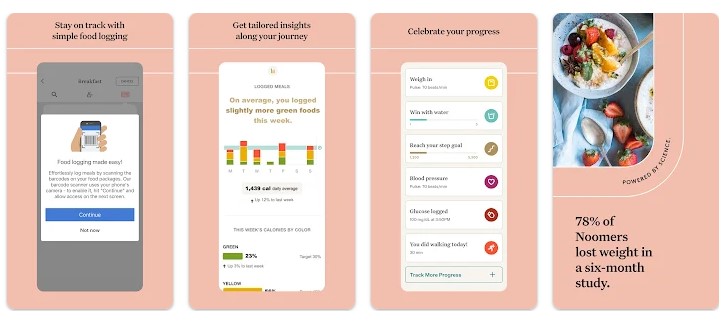
Noom comes close to Foodvisor and offers excellent educational resources to teach people about nutrition, behavioral changes, etc.
The app’s daily lessons are a game-changer for people, and Noom’s unique approach to classifying foods based on their nutritional and energetic value makes it easier to eat better on a day-to-day basis.
MacroFactor
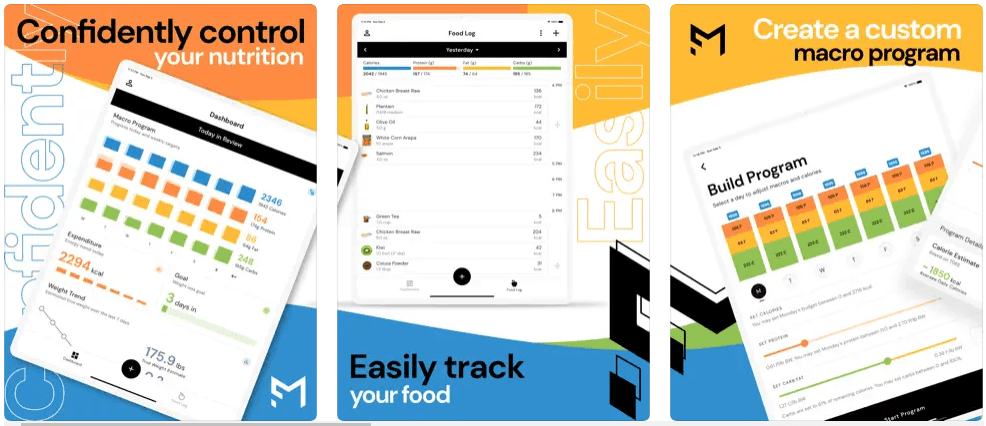
MacroFactor is similar to Foodvisor in some ways. It gathers data to understand users’ needs better and teaches people nutritional fundamentals, how calorie needs change over time, and much more.
That said, MacroFactor is superior in a few ways, especially for more experienced users. It has built-in coaching capabilities, which means the user’s nutritional targets change over time based on weight trends and other factors.
MacroFactor also has a richer food library and more thorough breakdowns of each entry, including information about the amino acid profile of proteins.
To top it off, users can log far more than just their body weight, including tracking their body fat and measurements, uploading progress photos, and more.
Frequently Asked Questions
How Much Does Foodvisor Cost?
Foodvisor offers a 14-day free trial. However, the way it’s set up, you must first decline to purchase a plan to get the option.
Once the trial ends, subscription options start from:
- Monthly Payments: $29.99
- 3-Month Membership: $59.99
- 6-Month Plan: $124.99
Is Foodvisor Good For Weight Loss?
Foodvisor can be good for weight loss. The initial nutritional targets seem to be accurate, the recipe database has plenty of low-calorie recipes, daily reminders promote accountability, and having access to a nutritionist can be quite helpful.
Is Foodvisor Compatible With the Apple Watch?
Foodvisor is compatible with the Apple Watch and Apple Health.
How Do I Cancel My Foodvisor Subscription?
You can cancel your Foodvisor subscription under the ‘Subscription’ tab on the App Store. It’s important to do so at least a day before your next payment is due.
How Do I Contact Foodvisor?
You can contact the Foodvisor team by sending a DM to your assigned nutritionist through the app’s dashboard or by clicking on ‘Contact us’ at the bottom of the settings options.
About The Author

Philip Stefanov is a certified conditioning coach, personal trainer, and fitness instructor. With more than nine years of experience in the industry, he’s helped hundreds of clients improve their nutritional habits, become more consistent with exercise, lose weight in a sustainable way, and build muscle through strength training. He is passionate about writing and has published more than 500 articles on various topics related to healthy nutrition, dieting, calorie and macronutrient tracking, meal planning, fitness and health supplementation, best training practices, and muscle recovery.
Why Trust Our Content

On Staff at FeastGood.com, we have Registered Dietitians, coaches with PhDs in Human Nutrition, and internationally ranked athletes who contribute to our editorial process. This includes research, writing, editing, fact-checking, and product testing/reviews. At a bare minimum, all authors must be certified nutrition coaches by either the National Academy of Sports Medicine, International Sport Sciences Association, or Precision Nutrition. Learn more about our team here.
Have a Question?
If you have any questions or feedback about what you’ve read, you can reach out to us at [email protected]. We respond to every email within 1 business day.
